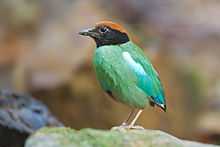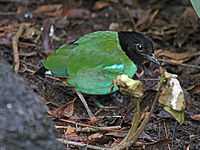Hooded pitta
| Hooded pitta | |
|---|---|
 | |
| Conservation status | |
| Scientific classification | |
| Kingdom: | Animalia |
| Phylum: | Chordata |
| Class: | Aves |
| Order: | Passeriformes |
| Family: | Pittidae |
| Genus: | Pitta |
| Species: | P. sordida |
| Binomial name | |
| Pitta sordida (Müller, 1776) | |
The hooded pitta (Pitta sordida) is a passerine bird. It is common in eastern and southeastern Asia and maritime Southeast Asia, where it lives in different types of forests as well as on plantations and other cultivated areas.
Hooded pittas can reach a length of 16 to 19 cm and a weight of 42 to 70 g. Their diet consists of various insects (including their larvae), which they hunt on the ground, and berries. In the breeding period, which lasts from February to August, they build nests on the ground; both parent take care of the eggs and the fledglings. They are highly territorial and their fluty double-noted whistle calls ("qweeek-qweeek") can be constantly heard from their territories, sometimes throughout the nights.
In captivity, hooded pittas mix well with other species although they may be aggressive toward other pittas when breeding. In London Zoo they are kept in a large walk-through aviary in the restored Blackburn Pavilion bird house, while at the Durrell Wildlife Park they are in a large walk-through exhibit with birds such as Palawan peacock-pheasants and white-rumped shamas.
Gallery
References
- ↑ BirdLife International (2012). "Pitta sordida". IUCN Red List of Threatened Species. Version 2013.2. International Union for Conservation of Nature. Retrieved 26 November 2013.

